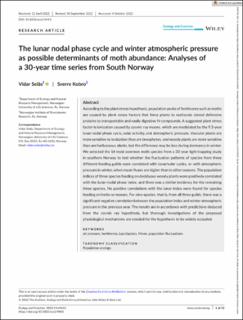| dc.contributor.author | Selås, Vidar | |
| dc.contributor.author | Kobro, Sverre | |
| dc.date.accessioned | 2022-12-27T14:20:37Z | |
| dc.date.available | 2022-12-27T14:20:37Z | |
| dc.date.created | 2022-11-22T13:04:50Z | |
| dc.date.issued | 2022-10-27 | |
| dc.identifier.citation | Ecology and Evolution. 2022, 12 (10), . | en_US |
| dc.identifier.issn | 2045-7758 | |
| dc.identifier.uri | https://hdl.handle.net/11250/3039578 | |
| dc.description.abstract | According to the plant stress hypothesis, population peaks of herbivores such as moths are caused by plant stress factors that force plants to reallocate stored defensive proteins to transportable and easily digestive N-compounds. A suggested plant stress factor is ionization caused by cosmic ray muons, which are modulated by the 9.3-year lunar nodal phase cycle, solar activity, and atmospheric pressure. Vascular plants are more sensitive to ionization than are bryophytes, and woody plants are more sensitive than are herbaceous plants, but the difference may be less during dormancy in winter. We selected the 14 most common moth species from a 30-year light-trapping study in southern Norway to test whether the fluctuation patterns of species from three different feeding guilds were correlated with lunar/solar cycles, or with atmospheric pressure in winter, when muon fluxes are higher than in other seasons. The population indices of three species feeding on deciduous woody plants were positively correlated with the lunar nodal phase index, and there was a similar tendency for the remaining three species. No positive correlations with the lunar index were found for species feeding on herbs or mosses. For nine species, that is, from all three guilds, there was a significant negative correlation between the population index and winter atmospheric pressure in the previous year. The results are in accordance with predictions deduced from the cosmic ray hypothesis, but thorough investigations of the proposed physiological mechanisms are needed for the hypothesis to be widely accepted. | en_US |
| dc.description.abstract | The lunar nodal phase cycle and winter atmospheric pressure as possible determinants of moth abundance: Analyses of a 30-year time series from South Norway | en_US |
| dc.language.iso | eng | en_US |
| dc.publisher | John Wiley & Sons Ltd. | en_US |
| dc.rights | Navngivelse 4.0 Internasjonal | * |
| dc.rights.uri | http://creativecommons.org/licenses/by/4.0/deed.no | * |
| dc.title | The lunar nodal phase cycle and winter atmospheric pressure as possible determinants of moth abundance: Analyses of a 30-year time series from South Norway | en_US |
| dc.title.alternative | The lunar nodal phase cycle and winter atmospheric pressure as possible determinants of moth abundance: Analyses of a 30-year time series from South Norway | en_US |
| dc.type | Peer reviewed | en_US |
| dc.type | Journal article | en_US |
| dc.description.version | publishedVersion | en_US |
| dc.rights.holder | © 2022 The Authors | en_US |
| dc.source.pagenumber | 12 | en_US |
| dc.source.volume | 12 | en_US |
| dc.source.journal | Ecology and Evolution | en_US |
| dc.source.issue | 10 | en_US |
| dc.identifier.doi | 10.1002/ece3.9443 | |
| dc.identifier.cristin | 2078177 | |
| dc.source.articlenumber | e9443 | en_US |
| cristin.ispublished | true | |
| cristin.fulltext | original | |
| cristin.qualitycode | 1 | |

